 I know it gets confusing but this list is a bit different from the Calde-not list from a couple days ago. The reason is simple. While the Calde-not list looks primarily at books with illustrations so distinguished they could easily win major illustration awards if given half a chance, this is list is more for those books that may not blow you away on a first glance, but that make our publishing landscape richer for their very existence. I was inordinately pleased after I read each and every one of these books. They’re a little peculiar, distinctly different from what you’ll find in the American market, and altogether remarkable.
I know it gets confusing but this list is a bit different from the Calde-not list from a couple days ago. The reason is simple. While the Calde-not list looks primarily at books with illustrations so distinguished they could easily win major illustration awards if given half a chance, this is list is more for those books that may not blow you away on a first glance, but that make our publishing landscape richer for their very existence. I was inordinately pleased after I read each and every one of these books. They’re a little peculiar, distinctly different from what you’ll find in the American market, and altogether remarkable.
2016 International Imports for Kids
Picture Books
Chirri & Chirra by Yuki Kaneko

Sweet and dreamlike, this Japanese import has a light and sweetness to it that will simultaneously make it deeply beloved in a few select homes, while also not drawing so much attention to itself that it ever becomes much more than a cult hit in the States. Do yourself a favor and discover it. It’s the kind of book you want to influence the dreams of your children with.
Cry, Heart, But Never Break by Glenn Ringtved, ill. By Charlotte Pardi
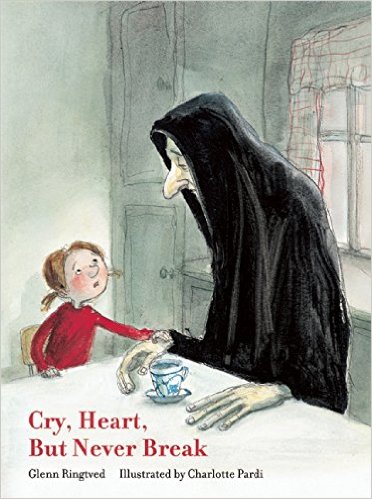
This Danish import just reminds us that when it comes to poetic picture books about death, American just don’t deal very well. Our death books tend to either be straightforward guides (here’s what to expect, etc.) or complete and utter fanciful metaphors. This book feels like it’s both fable and straightforward talk. A rare thing.
The Day I Became a Bird by Ingrid Chabbert, ill. Guridi

Kirkus didn’t get it. SLJ did. In this story a boy falls in love with a bird-loving girl. To get her attention he constructs an elaborate bird costume. Make of that what you will.
Don’t Cross the Line! by Bernardo P. Caravalho, ill. Isavel Martins

Portugal! And an interesting book at that. This one combines the interactive qualities of something like Don’t Let the Pigeon Drive the Bus or Press Here with a political statement about thwarting unjust authority. This book may get a bit more play in the coming years.
Look Up by Jung Jin-Ho

I love this one since it confronts and rearranges the reading experience and expectations of children. Add in the fact that it stars a girl in a wheelchair (who is not solely defined as a person from that chair) and you’ve got a golden book on your hands.
My Baby Crocodile by Gaetan Doremus
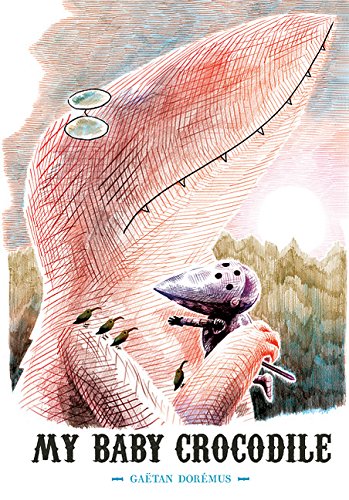
Funny story. I cannot read this book without setting it to the tune of “My Funny Valentine”. I suspect that this is because the two phrases share the same number of syllables more than anything else, but maybe it also has to do with the strange nature of love celebrated in this book. The story is between a near-sighted crocodile that “adopts” a knight, thinking he’s a baby croc. It’s odd and sweet and strange and funny. Memorable too.
A Promise Is a Promise by Knister, ill. Eve Tharlet

I found this one interesting perhaps because of the deep-seated feeling of betrayal our hero suffers in the course of things. It’s a very childlike understanding of an impossible promise and I like how it’s handled. A book that belies its cutesy cover.
Undercover by Bastien Contraire
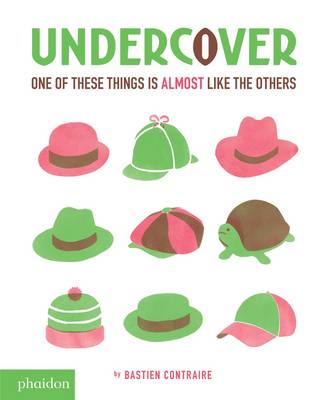
I absolutely adore this book. It’s a story where you have to spot the thing that doesn’t match. Contraire, living up to his name, doesn’t make it easy on you, though. The cover alone should be enough to prove that to you.
What Color Is the Wind? By Anne Herbauts
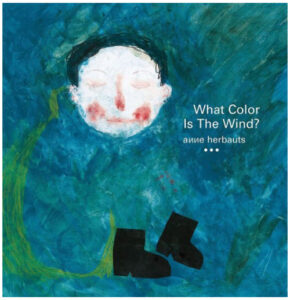
I’ve already reviewed it but if you somehow missed mention of this marvelous books about blindness and tactile response, now’s the time. You won’t find anything else like it on the market today.
Why Am I Here? by Constance Orbeck-Nilssen, ill. Akin Duzakin

Big questions for little brains. I like this one a lot. Lemur or not lemur.
Middle Grade
The Birth of Kitaro by Shigeru Mizuki

Honestly the backmatter explaining the entire history of the yokai in Japanese history and literature is some of the most fascinating stuff here. In a way, this book reads like what would have happened if Quasimodo turned into a superhero rather than a bell fantastic. I loved the peculiar (to me) nature of the storylines, the characters, and particularly the creatures.
The Heartless Troll by Oyvind Torseter
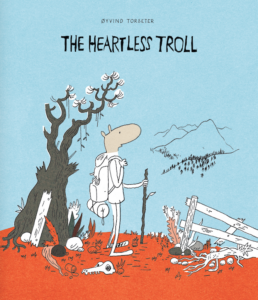
The troll is, without a doubt, one of the most horrific renderings I’ve seen in a children’s book in a long time. Which is to say – it’s awesome! Definitely hand this to older kids, but appreciate it on your own when you get a chance. As graphic novels go, there are few things to compare it to.
Under Earth / Under Water by Aleksandra Mizielinska and Daniel Mizielinski
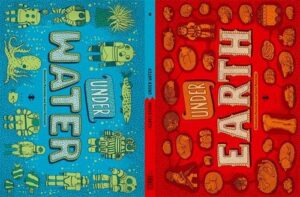
This Polish import is fantastic. There was a book of maps that came out from this couple previously. I’m not as big a fan of those, but what I am a fan of is learning about all that goes on below. Good times.
Misc
And just a quick shout-out to the Candied Plums titles that aren’t online yet. These are the real deal. I just adore them:
- Little Rabbit’s Questions by Dayong Gan, translated by Helen Wang (978194529270 – www.candiedplums.com)
- Picking Turnips by Xu Zhou, translated by Adam Lanphier (9781945295263 – www.candiedplums.com)
- Who Wants Candied Hawberries? by Dongni Bao, ill. Di Wu, translated by Adam Lanphier
Interested in the other lists of the month? Here’s the schedule so that you can keep checking back:
December 1 – Board Books
December 2 – Board Book Adaptations
December 3 – Nursery Rhymes
December 4 – Picture Book Readalouds
December 5 – Rhyming Picture Books
December 6 – Alphabet Books
December 7 – Funny Picture Books
December 8 – Calde-Nots
December 9 – Picture Book Reprints
December 10 – Math Picture Books
December 11 – Bilingual Books
December 12 – International Imports
December 13 – Books with a Message
December 14 – Fabulous Photography
December 15 – Fairy Tales / Folktales
December 16 – Oddest Books of the Year
December 17 – Older Picture Books
December 18 – Easy Books
December 19 – Early Chapter Books
December 20 – Graphic Novels
December 21 – Poetry
December 22 – Fictionalized Nonfiction
December 23 – American History
December 24 – Science & Nature Books
December 25 – Transcendent Holiday Titles
December 26 – Unique Biographies
December 27 – Nonfiction Picture Books
December 28 – Nonfiction Chapter Books
December 29 – Novel Reprints
December 30 – Novels
December 31 – Picture Books

 Fox’s Garden
Fox’s Garden
By Princesse Camcam
Enchanted Lion Books
ISBN: 978-1-59270-167-4
$14.95
Ages 3-6
On shelves now.
Have you ever read a picture book multiple times, enjoying it with each and every read, and then find later that it was wordless . . . and you didn’t even notice? Now THAT is the mark of an effective title. The publisher Enchanted Lion Books prides itself on its “Stories Without Words” series, and deservedly so. They import wordless picture books from abroad, format them into these long, slender books, and subsequently prove to the world that good storytelling is universal. It goes beyond language. The latest in this long line of beauties is, to my mind, the most impressive offering to date. Fox’s Garden by author Princesse Camcam (who edges out Sara Pennypacker, Mary Quattlebaum, and Robert Quackenbush in the Best Children’s Author’s Name contest) is ostensibly a very simple story about kindness and unexpected rewards. Combined with remarkable cut paper scenes that are lit and photographed in an eerie, wonderful way, this is a book that manages to simultaneously convey the joy that comes after a simple act of kindness as well as the feel and look of winter, night and day.
On a cold and windy night, when the snow blows in high drifts, a single fox plunges onward. When a warm, inviting village appears in a valley she makes her way there. However, once there she is summarily rejected by the hostile townspeople, at last taking refuge in a small greenhouse. A small boy spots the fox’s presence and goes to offer her some food. When he finds her, he sees that she is not alone. Newborn kits suckle, so he leaves the edibles at a safe distance and goes inside to bed. In the early morn the fox and her brood prepare to leave but before doing so they leap through the boy’s window, planting flowers in his floor so that he wakes up to a wonder of blossoms of his very own.
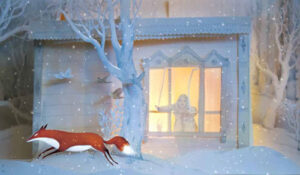 The fact of the matter is that I’ve seen cut paper work in picture books before, whether it’s the scale models in books like Cynthia von Buhler’s But Who Will Bell the Cats? or the distinctive Lauren Child style of The Princess and the Pea. But books of that sort are part cut paper and part dollhouse, to a certain extent, since they utilize models. Titles that consist of cut paper and lighting alone are rarities. Even as I write this it sounds like such a technique would be some fancy designer’s dream and not something appealing to kids. Yet what makes Camcam’s style so appealing is that it combines not just technical prowess but also good old-fashioned storytelling. The glow that emanates from behind some of the homes in the snowy winter village looks infinitely appealing. You can practically feel the heat that would strike you as you entered through one of those doorways. Even more impressive to me, however, was the artist’s ability to capture winter daytime cloudy light. You know that light I’m talking about. When snow has blanketed the earth and the white/gray clouds above give off this particular winter gleam. I’m used to complimenting illustrators on how well they portray winter light in paint. I’m less accustomed to praising that same technique in sliced up paper.
The fact of the matter is that I’ve seen cut paper work in picture books before, whether it’s the scale models in books like Cynthia von Buhler’s But Who Will Bell the Cats? or the distinctive Lauren Child style of The Princess and the Pea. But books of that sort are part cut paper and part dollhouse, to a certain extent, since they utilize models. Titles that consist of cut paper and lighting alone are rarities. Even as I write this it sounds like such a technique would be some fancy designer’s dream and not something appealing to kids. Yet what makes Camcam’s style so appealing is that it combines not just technical prowess but also good old-fashioned storytelling. The glow that emanates from behind some of the homes in the snowy winter village looks infinitely appealing. You can practically feel the heat that would strike you as you entered through one of those doorways. Even more impressive to me, however, was the artist’s ability to capture winter daytime cloudy light. You know that light I’m talking about. When snow has blanketed the earth and the white/gray clouds above give off this particular winter gleam. I’m used to complimenting illustrators on how well they portray winter light in paint. I’m less accustomed to praising that same technique in sliced up paper.
The shape of the book itself is an interesting choice as well. The publisher Enchanted Lion specializes in these long thin books, so I wasn’t quite sure if the book originally published (under the name “Une rencontre”) in the same format. To my mind it feels as though it was always intended to look this way. Just watching where the gutter between the two pages falls is an interesting exercise in and of itself. The first two-page spread shows the fox struggling, belly low, through snowdrifts. She’s on the right-hand page, the desolate woods behind her. When she spots the village she is on the left page and the town looks warm and inviting on the opposite side. Distant, because of the nature of the layout, but comforting. Interestingly the only time the two pages show two different scenes is when you see people kicking and yelling at the fox. In contrast to the rest of the book the two different images make everything feel tense and angry. Landscapes are calming. From there on in everything is a two-page spread, sometimes presenting a close-up shot (there is an amazing image of the happy fox in the foreground on the left page, while the boy is in the distant doorway of the greenhouse on the right) and sometimes an image of distance, as with the final shot.
 It isn’t just the art that had me fail to recognize that the book was wordless. Camcam’s vixen seems to tell whole stories with just a glance here and there. She’s a proud animal. You understand that even as she’s kicked and cursed she’s retaining her dignity. The boy’s act of kindness may be given because he sees a creature in need, but it seems as though it’s just as likely that he’s helping her because she is worth worshipping anear. And though she and her brood do something particularly un-foxlike near the end she is, for the most part, not anthropomorphized. The storytelling sounds so oddly trite when I summarize the book, but it doesn’t feel trite in the least. You could easily see this book adapted into a ballet or similar wordless format. It’s a naturally beautiful tale.
It isn’t just the art that had me fail to recognize that the book was wordless. Camcam’s vixen seems to tell whole stories with just a glance here and there. She’s a proud animal. You understand that even as she’s kicked and cursed she’s retaining her dignity. The boy’s act of kindness may be given because he sees a creature in need, but it seems as though it’s just as likely that he’s helping her because she is worth worshipping anear. And though she and her brood do something particularly un-foxlike near the end she is, for the most part, not anthropomorphized. The storytelling sounds so oddly trite when I summarize the book, but it doesn’t feel trite in the least. You could easily see this book adapted into a ballet or similar wordless format. It’s a naturally beautiful tale.
Let’s examine that word for a second. Beautiful. I don’t use it enough when I’m describing picture books. It’s not the kind of word you should bandy about for no reason. If I called every other book “beautiful” it would diminish the importance of the word and I couldn’t use it when something as truly stunning as this. It’s the kind of book that doesn’t feel like anything else you’ve seen or read. True and lovely and entirely unique. A book to borrow and a book to own.
On shelves now.
Source: Final copy sent from publisher for review.
Like This? Then Try:
Professional Reviews: A star from Kirkus
Misc: You can see a whole mess of spreads from the book over at Seven Impossible Things Before Breakfast

 Jumping Penguins by Jesse Goossens
Jumping Penguins by Jesse Goossens
Illustrated by Marije Tolman
Lemniscaat
$19.95
ISBN: 9781935954323
Ages 6-11
On shelves now.
Here’s a puzzler for you. See what you think. There’s been a lot of talk lately about nonfiction for kids and the importance of highlighting those books that adhere strictly to the truth. That means no invented dialog in biographies and no invented facts. If you conflate facts, you start getting into a murky, sticky area. As Walter de la Mare is reported to have said (and no, I’m not blind to the irony of not knowing if he actually said it), “only the rarest kind of best in anything can be good enough for the young.” That goes for our nonfiction too. If we can’t trust them with reality (albeit selective reality) what can we trust them with? So with all this in mind, a stanch staid steady trust in the real world at hand, what are we to make of books where the facts are all true (insofar as we know) but the illustrations are fanciful? No one is ever going to say that the Jesse Goossens book Jumping Penguins is anything but one-of-a-kind. The real question is whether or not you think its delightful flights of fancy help or hurt the material at hand.
Without so much as a howdy-do, Jumping Penguins leaps into the thick of it right from the start. Turn the page and here we have a rather delightful turtle birthday party looking at us. The turtle of the hour is wearing a party hat that reads “150” while before him (her?) other turtles pile on top of one another, Yertle-style. As your eye wanders to the text on the far right you start reading startling and interesting facts. There are 33 species of turtles. The largest weighs as much as a small car. The oldest tortoise of all time was 225 years old when it died. Flipping through the book you are struck by the variety of facts. Sometimes these can be incredibly short (including the near non sequitur “A polar bear is left-handed, as are most artists.”) while others fill out the page from top to bottom. Fun, original pictures filling near two-page spreads continue throughout the book. There’s no particular order to the animals, but by the end you feel you’ve seen a wide variety. An index appears at the end of the book.
This, ladies and gentlemen, is how you end a book. Jumping Penguins is memorable for many things, but it’s hard not really love the fact that the very last words you will read mere moments before closing the cover are, “Panther: A black panther is not a panther at all – it is a leopard that happens to be black.” Pithy and to the point. There is, however, a downside to Goossens’ cleverness. It’s a downside that probably does not exist in The Netherlands where this book (under the title “Springende pinguins en lachende hyena’s”, in case you’re curious) was originally published. The trouble is that aside from the Index, there is no backmatter to explain where exactly Ms. Goossens is getting her facts. We’re sort of taking it on faith that if you drop alcohol on a scorpion it will go crazy and sting itself to death. This would probably pose more of a problem if I could envision any way in the world in which this book could be integrated into a school curriculum. Fact of the matter is that it’s just a really fun, and rather beautiful, collection of animal facts. No more. No less. So while I wouldn’t necessarily go spouting these off without doing the most rudimentary of checks, I think we’re okay overall.
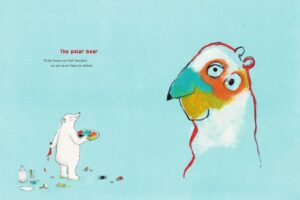 Not to say there aren’t some moments of confusion. In the seahorse section I already knew that the daddy seahorse is the one who actually lugs about the baby seahorses for long periods of time in his pouch. However, since Goossens doesn’t mention that the females really do give birth to the eggs in the first place, statements like “He gets pregnant again within a few days” can prove more than a little confusing. Alternately, I rather liked the longer words and vocabulary terms that are spotted throughout the text. The casual understanding that the reader is familiar with words like “vertebrae”, “defecate”, and “nocturnal” gives the child reader the benefit of the doubt. I’m rather partial to that.
Not to say there aren’t some moments of confusion. In the seahorse section I already knew that the daddy seahorse is the one who actually lugs about the baby seahorses for long periods of time in his pouch. However, since Goossens doesn’t mention that the females really do give birth to the eggs in the first place, statements like “He gets pregnant again within a few days” can prove more than a little confusing. Alternately, I rather liked the longer words and vocabulary terms that are spotted throughout the text. The casual understanding that the reader is familiar with words like “vertebrae”, “defecate”, and “nocturnal” gives the child reader the benefit of the doubt. I’m rather partial to that.
Clearly illustrator Marije Tolman is supposed to be the main draw here. How else to explain the fact that ONLY her name appears on the spine of the book (the cover doesn’t sport any words at all, so there you go there)? Certainly the art here offers a whole second way of reading the book. What Tolman has done that’s so neat is to illustrate each section with this silly, upbeat style while at the same time including lots of little elements that tie directly into the descriptive text. The Scorpion section, for example, contains about five different little drawn vignettes of various scorpions. It takes a careful reading of the text to realize what they’re getting at. The scorpion wearing three pairs of sunglasses? Well, that connects to the line “Scorpions have six eyes and some even have twelve but they cannot see well”. Slowly you can pair up each picture with the statement, but what becomes clear is that the illustrations in this book will not make any sense unless you do more than skim the pretty pics. Fortunately those same pics are also funny as well as occasionally quite beautiful (I’m personally rather fond of the Giant Octopus).
What Jumping Penguins does better than anything else is simply set up an appreciation for the natural world by way of its modest peculiarities. I mean, what exactly are we supposed to do with the information that “A giraffe has no vocal cords. It has as many vertebrae as you do”? There is no practical application for the knowledge you will find here. And that, I would argue, is actually its strength. Without relying on a specific hook (or precedent, for that matter) the combined efforts of Goossens and Tolman present you with something that looks, at first glance, like a picture book. Linger with it long and it’s rapidly clear that the overwhelming sense at the end is that the natural world is an awesome place. How many other animal fact books can say so much? Read this and you’ll find yourself amazed that you never knew half these facts. This is a book to inspire that most impossible of feelings: Wonder.
On shelves now.
Source: Final copy sent from publisher for review.
Like This? Then Try:
Other Blog Reviews:
Professional Reviews:
Misc: Happy Nonfiction Monday to you! The roundup of the day is at NC Teacher Stuff. Head on over there to see everything that everyone is linking to today.







 I know it gets confusing but this list is a bit different from the Calde-not list from a couple days ago. The reason is simple. While the Calde-not list looks primarily at books with illustrations so distinguished they could easily win major illustration awards if given half a chance, this is list is more for those books that may not blow you away on a first glance, but that make our publishing landscape richer for their very existence. I was inordinately pleased after I read each and every one of these books. They’re a little peculiar, distinctly different from what you’ll find in the American market, and altogether remarkable.
I know it gets confusing but this list is a bit different from the Calde-not list from a couple days ago. The reason is simple. While the Calde-not list looks primarily at books with illustrations so distinguished they could easily win major illustration awards if given half a chance, this is list is more for those books that may not blow you away on a first glance, but that make our publishing landscape richer for their very existence. I was inordinately pleased after I read each and every one of these books. They’re a little peculiar, distinctly different from what you’ll find in the American market, and altogether remarkable.





















This looks gorgeous and I’m looking forward to reading it. It’s at least the second title Enchanted Lion has published with cut paper, as MY FATHER’S ARMS ARE A BOAT uses a similar style. I think cut paper in three dimensions is becoming at least somewhat more prevalent–it shows up in THE MIGHTY LALOUCHE by Sophie Blackall, YOU ARE STARDUST by Elin Kelsey, illus. by Soyeon Kim and in a slightly more presentational style, Carin Berger’s work for STARDINES FLY HIGH ACROSS THE SKY by Jack Prelutsky.